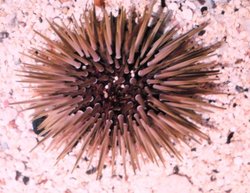Echinoderm
|
|
| Echinoderms | ||||||
|---|---|---|---|---|---|---|
 Sea urchin | ||||||
| Scientific classification | ||||||
| ||||||
| Classes | ||||||
Echinoderms (Echinodermata) is a phylum of marine animals found in the ocean at all depths. This phylum dates back to the lower Cambrian period and represents about 7000 living species and 13000 extinct ones. 6 classes made it to the Modern Era:
- Asteroidea (asteroids / starfishes or sea stars): 1,500 species that capture prey for their own food.
- Concentricycloidea (sea daisies), have a unique water vascular system.
- Crinoidea (crinoids / feather stars or sea lilies): 600 species that are suspension feeders.
- Echinoidea (echinoids / sea urchins and sand dollars): 1,000 species; members of that class have movable spines.
- Holothuroidea (sea cucumbers): 1,000 species, elongated animals resembling slugs.
- Ophuiroidea (brittle stars and basket stars), the largest class of echinoderms.
Fossil forms included Blastoids, Edrioasteroids and several peculiar Early Cambrian animals such as Helioplacus, Carpoids, Homalozoa and possibly Machaerids.
They evolved from bilaterally symmetric creatures. Later forms were lopsided. Echinoderms' larvae are ciliated free-swimming organisms that organize in a bilaterally symmetric fashion that makes them look like embryonic chordates. Later, the left side of the body grows at the expense of the right side, which is eventually absorbed. The left side then grows in a pentaradially symmetric fashion, in which the body is arranged in five parts around a central axis.
All echinoderms exhibit fivefold radial symmetry in portions of their body at some stage of life, even if they have secondary bilateral symmetry. They also have a mesodermal endoskeleton made of tiny calcified plates and spines, that forms a rigid support contained within tissues of the organism; some groups have modified spines called pedicellariae that keep the animal free of debris.
Echinoderms possess a hydraulic water vascular system, a network of fluid-filled canals that function in locomotion, feeding, and gas exchange. They also possess an open and reduced circulatory system, and have a complete digestive tube (tubular gut).
They have a simple radial nervous system that consists of a modified nerve net (interconnected neurons with no central organs); nerve rings with radiating nerves around the mouth extending into each arm; the branches of these nerves coordinate the movements of the animal. Echinoderms have a brain, although it is very small.
The sexes are usually separate, and eggs and sperms are generally released into the water, in which case fertilization takes place externally.
Many echinoderms have remarkable powers of regeneration: a starfish cut radially into a number of parts will, over the course of several months, regenerate into as many separate, viable starfish. A section as small as a single arm (with the commensurate central-body mass and neural tissue) will, in ideal circumstances, successfully regenerate in this way.
Echinoderms, like chordates, are deuterostomes and are therefore thought to be the most closely related of the major phyla to the chordates, being a sister group to chordates plus hemichordates. (Some believe that acorn worms are more closely related to echinoderms than chordates.) Because of a controversial interpretation of Homalozoa, a minority of classifiers place the echinoderms into the Chordata.
Echinodermata is the largest phylum to lack any fresh water or land representatives. Template:AnimalClipart marine
External links
- Echinodermata (http://tolweb.org/tree?group=Echinodermata&contgroup=Deuterostomia) from the Tree of Life website.
- Echinoderms (http://www.northwestdiver.com/creature_feature/echinoderms.php) from the Creature Feature website.
